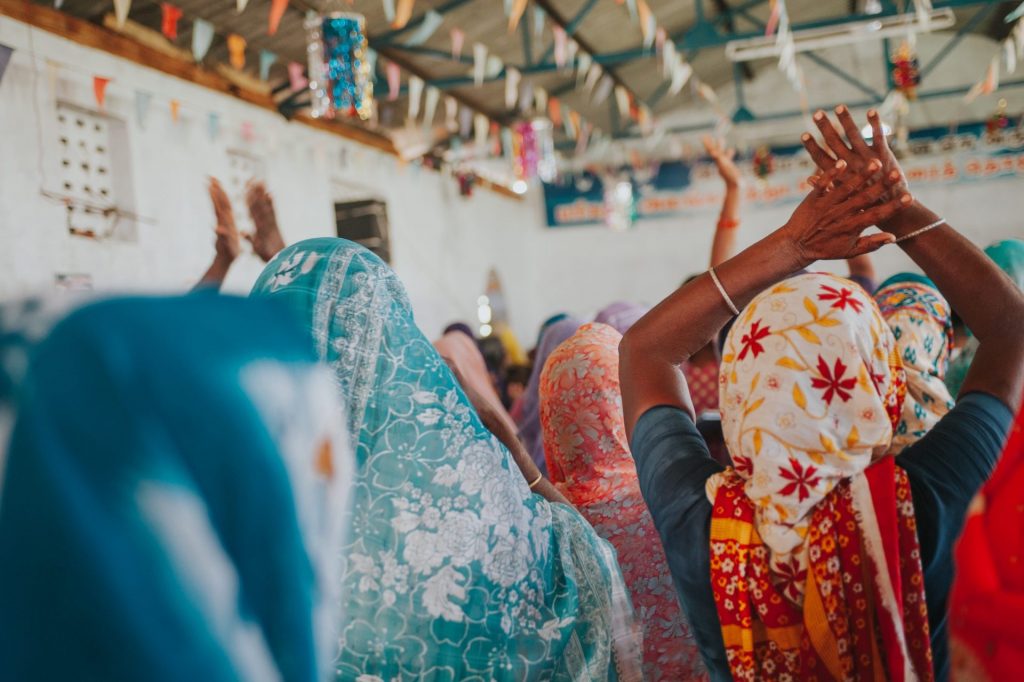Editor’s Note: Christians around the World is a series of articles in which we see churches in multiple nations pursuing the same mission: making disciples and planting churches among unreached peoples and places. You can view part one here, and part two here.
Missionaries sometimes say that worshiping in a cross-cultural context is a dress rehearsal for a Revelation 7:9 eternity. As a cross-cultural worker, I agree. But if I’m honest, sometimes the rehearsal is pretty awkward.
I live in South Asia among a culture whose worship is loud, long, and—perhaps most uncomfortable for a Baptist—moving. Many South Asian Christians love to worship with what they call “action songs,” and they encourage enthusiastic participation from everyone, no exceptions. There’s foot movement, continuous clapping, sometimes jumping. Like I said, awkward.
Awkward, but not wrong. Because just as God created all peoples to reflect His multifaceted image, He inspires worship that glorifies Him through a kaleidoscope of cultures.
In John’s Revelation 7:9–10 vision, God enjoys His deserved praise from all peoples. So to give us a tiny taste of that glorious eternity, we’ve rounded up ten audio clips of worship styles from around the world and asked our missionaries to describe worship in those contexts. May increasingly more people join us in this global chorus to our Creator.
Russia

A church service in a Russian context is typically very traditional and structured. Instrumentation is modest but not minimalist: a keyboard, acoustic guitar, a shaker, and a cajon.
The song above reads like a Psalm, saying, “I will praise the Lord Christ / I will remember all his works / I will be singing hallelujah to him.” (Full song in Russian here)
One difference a worker described between her US church and her church among Russians is that during the service anyone is welcome to share a personal testimony of God’s grace or give an account of an evangelism opportunity they had.
Thailand
One IMB worker described worship in his church in Thailand as “modest, genuine, and passionate.” Each Sunday, a handful of vocalists accompanied by an acoustic guitar, a keyboard, and a cajon leads worshipers in a rhythm of song and prayer, song and prayer.
Because the worker’s church is in a city that’s regularly exposed to foreigners, particularly Westerners, the church has adopted a mix of local Thai songs and Western songs translated into Thai. Many of us can likely identify the song above (here’s the English version).
Nepal

Though the historical culture of each people is slowly being phased out by “Westernized” youth, many churches in Nepal still use traditional instruments and language. They feel it’s important to use their own music styles and dance to worship God. The older generations prefer to sing to God with their own instruments—the mandolin, gyumang, and madal—and musical tones they grew up knowing and loving.
One worker among Nepali peoples says the worship is not governed by time or a song list. Rather, at any time, anyone can pray aloud, even in the middle of a song. Worshipers often dance, clap, and tearfully shout their prayers to God throughout the service. In the song above, they proclaim, “I give my life, my spirit as worship to you. / . . . / I kneel before you and kiss your feet. / Let my life be a life of worship to you.”
India

India is a country that loves high volume, pomp, and pizzazz, and those characteristics often accompany worship in church, particularly in rural areas. Churches that can afford it install booming sound systems that project electrified notes from keyboards and guitars. One song may go on for ten minutes, concluded by a prayer that runs into the next song. Worship often comprises half of a service that’s usually over two hours long.
Many Indians move while they worship. Whether it’s in the form of choreographed actions or it spontaneously emerges from a worshiper, movement is said to communicate that someone is worshiping God with all their heart, mind, soul, and strength.
Turkey
Although many Turkish churches weave translated Western songs into their services, many of their songs are Turkish born. Turkish songs tend to be written in minor keys, enabling worshipers to sometimes sing in tones that aptly reflect hearts yearning to bring lament and sorrow before the Lord. Even so, Turkish worship services aren’t entirely somber. Turks stand, raise their hands, and clap in syncopated beats. Most churches use guitars, drums, a keyboard, and sometimes a saz, a traditional Turkish instrument.
The song above is about love—God’s love for us and our love for one another. It’s taken from 1 John 4:7–11, where the apostle reminded believers to “love one another. . . . God’s love was revealed among us in this way: God sent His One and Only Son into the world so that we might live through Him.”
Ghana
Musical worship in West African church services almost always includes expressive, animated dancing. Ghanaian music, like most of West Africa, is based primarily on rhythm, not melody. They keep the beat with traditional instruments like bongo drums, shakers, or cowbells—occasionally a two-stringed banjo or one-stringed fiddle. Nowadays, however, churches in towns and cities use modern drum kits, electric keyboards, and electric guitars.
South Africa

Music is integral to South African culture. Music in this highly diverse country can be an expression of community, so worship songs are sung as a shared experience among a body of Christians. For instance, a single vocalist starts the song, then the rest of the congregation finishes his phrase—a pattern that continues throughout the entire song. It’s like a communal conversation to God.
A good rhythm is extremely important, but instruments are optional. The words to the song above, for instance, are sung acapella with claps maintaining the beat, instead of a guitar or drums. The song—with phrases started by a leader and finished by the congregation—is about the love of God: “It wakes me from my sleep (It’s amazing!) / it’s not like man’s love (it’s amazing!) / people’s love ends but not Jesus’s (it’s amazing!).”
Brazil

One IMB missionary family worships with a remote tribe that was first evangelized by a German missionary in the sixties. Many of the worship songs the tribe first learned were American hymns translated into local languages, and those songs remain staples in worship services today. The church you hear in the song above is diligently pursuing people outside their tribe with the gospel, so it’s not unusual to sing songs in three or four languages during a service.
Recently, the church started using a guitar, drum set, and keyboard rather than exclusively local instruments. This particular tribe’s culture is reserved and quiet, so worship services tend to be rather somber experiences.

